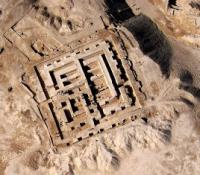Вы здесь
Ulug-depe ancient settlement.




Excursion on ancient settlement Ulug-depe in Turkmenistan.
The ancient settlement Ulug-depe - the basic in Central Asia with chronology from the end of the Neolithic till the akhemenidy period. It logs in large settlements of ancient farmers of a foothill strip of Kopet Dagh - Cara-depe, to Namazga-depa, Altyn-depe and Yylgynly-depa.
However in the XX century this monument was practically not investigated. The exception is made by local works of V. I. Sarianidi in the late sixties on opening of ceramic furnaces for roasting of pottery which were carried out for the purpose of studying of features of ancient potter's production of an era of an eneolit and bronze.
Ulug-depe, which means the great depe in Turkmenistan, rises in an imposing silhouette before Kopetdagh, the mountain chain which separates the plain of the Turkmen piedmont from the Iranian plateau to the south.
From a height of some thirty metres which the site has attained today, the view reaches a distance of 15 km on all sides. But if we attribute an average height of ten metres to the monumental constructions which occupied the summit, the relief formed by the other tepes as well as the movements of men and herds could be distinguished up to a distance of thirty kilometres.
It is of course the presence of water, here the Kelet river, which influenced the choice and the place to establish human occupation. This river, whose source is in Iran, has carved a deep, narrow valley across Kopet Dagh and flows into the plain some ten kilometres upriver from Ulug Depe, forming a natural passage between southern central Asia and the Iranian plateau.
It is not insignificant that if a straight line is drawn perpendicular to Kopetdagh from Ulug-depe to Iran, it ends in the region of Nishapur, not far from Meshed, in the Kuh-e Binalud mountains which contain one of the principal deposits of turquoise in Khorassan.
Such geographic, environmental and strategic conditions occur in only two other places in the mountain chain, at Anaw near Ashkhabad, and at Namazga, forty kilometres to the west of our site. These are two major monuments of Turkmen antiquity of which the first has produced vestiges of the proto-Chalcolithic, the Bronze Age, and the early Iron Age.
From the excavations of the second, Namazga Depe, Soviet archaeologists were able to establish a stratigraphic and chrono-cultural sequence for all the sites on the plain of the piedmont of Kopetdagh and even beyond.
The different periods of these sites are thus referred to as Namazga I to Namazga VI, from the Chalcolithic to the end of the late Bronze; to qualify the following Iron Age periods, the reference is to Yaz Depe in the delta of the Murghab river (Margiana).
Thus Yaz I refers to the early Iron Age and Yaz II-III refers to the middle and late Iron Age. The size of the settlements of Central Asia is not comparable to those of Elam or Syro-Mesopotamia some of which cover, from the Chalcolithic onward, hundreds of hectares (240 at Uruk, for example).
Namazga Depe, the largest site of southern central Asia, is no larger than fifty hectares; Altyn Depe, the main site of the eastern piedmont of Kopet Dagh, covers forty hectares; Ulug Depe is in third position with twenty-six hectares at its base and ten at its top.
However, of all the central Asian sites, it possesses the longest stratigraphy known so far (from Namazga I to Yaz II-III): from the early Chalcolithic to the end of the Iron Age, probably including the Achaemenid period.
Moreover, evidence (lithic tools) discovered during excavation of the Chalcolithic levels of the site indicate a strong possibility that a settlement of the end of the Neolithic (Jeitun type) would have been the oldest occupation.
Authority:
On materials of information department of the State committee of Turkmenistan on tourism and sport. "Religious and spiritual monuments to Central Asia". Author M. Hashimov. Saga publishing house, 2001,
Photos:
Atamurad Guchgeldy.







